Hearthstone, like any card game, is constantly evolving. Every set brings new mechanics and cards to the game, and every few months the meta drastically shifts. While that keeps things fresh, it can also be a bit confusing and make the game hard to jump back into after a break. In this guide we will look at how the meta has shifted over the different sets that have come out over the past year and study how the game as changed. This should help anybody looking to get back into Hearthstone no matter when they’ve stopped playing.
Want to learn some more of the basics? Check out our Hearthstone Beginner’s Guide!
Wild and Standard
If you stopped playing during The Curse of Naxxramas or Goblins vs. Gnomes you may not know that competitive Hearthstone is now split into two different formats: Standard and Wild. In Standard, you can play only with cards from sets that came out in the past two years, while with Wild you can play with every card in the game. This changes with the first set of the new year. The most recent shift occurred with the release of Journey to Un’goro, and the next one will happen when the first set comes out in 2018.
Currently, the sets you can use in Standard are Whispers of the Old Gods, One Night in Karazhan, Mean Streets of Gadgetzan, Journey to Un’goro, Knights of the Frozen Throne and Kobolds & Catacombs. Anything else is only playable in Wild.
Now, to get caught up to speed on today’s Standard format, we are going to look at the different sets that have come out over the last two years and see how they have changed the game.
Card Pack Changes Regarding Legendaries
Between Journey to Un’Goro and Knights of the Frozen Throne, we had a patch that added some great changes to sets if you have yet to purchase packs from them. If you have not purchased a pack from a particular set you will be GUARANTEED a Legendary in your first 10 packs. To add to this, you will now no longer receive a duplicate Legendary in a pack (unless you own all of the Legendaries from that set). These changes allow you to build your collection faster, as well as get some fun cards to play around with.
It also means that if you’re a returning player, it might be a good idea to buy up to 10 packs from the expansions you’ve missed – buy them until you get your first Legendary. The value of the first 10 packs goes up heavily thanks to that change, and it’s worth to get them even if only to get more Arcane Dust.
If You Left Before Whispers of the Old Gods
Whispers brought the Standard format and put the game onto a new rotation schedule. In addition, Blizzard nerfed a series of powerful Basic and Classic cards they thought were too strong to stay in the game forever. Ancient of Lore only draws one card, Force of Nature costs five but lost charge, Keeper of the Grove is a 2/2, Ironbeak Owl costs 3 mana, Big Game Hunter costs 5, Hunter's Mark costs 1, and Blade Flurry costs four and only does damage to minions.
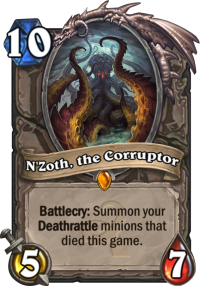
In addition, Abusive Sergeant only has one attack, Execute costs two, Charge costs 1 but the buffed minion can only attack minions, and Rockbiter Weapon costs two. Knife Juggler is a 2/2, Leper Gnome is a 1/1, Arcane Golem is a 4/4 but does not have charge, Master of Disguise only gives stealth for one turn, and Molten Giant now costs 25. For a very long time, most of those cards haven’t seen any play after the nerfs. More recently, Knife Juggler is commonly seen in Paladin, while Blade Flurry is a solid card in the Kingsbane Rogue deck.
Besides nerfs and rotation, the biggest additions in Whispers were the four old Gods. These are giant legendary minions that all have crazy, game-changing effects. N'Zoth, The Corruptor summons all your deathrattle minions that died during the game, Y'Shaarj, Rage Unbound summons a minion from your deck each turn, Yogg-Saron, Hope's End casts a random spell for each spell you cast that game (but stops if he gets killed, transformed, or silenced – this was added later as a nerf to the card), and C'Thun gets buffed every time you play a “C’thun” minion.
All of the four gods have seen play at different times, but N’Zoth and Y’Shaarj currently see the most. Yogg sees fringe play, mostly in “meme” decks after it’s been nerfed. C’Thun is the most interesting of the Gods because he has a slew of minions (such as Disciple of C'Thun that steadily buff him throughout the game. There are also cards like Ancient Shieldbearer that get bonuses if he has more than ten attack. You also receive C’Thun & 2x Beckoner of Evil for free when you open your first Whispers of the Old Gods pack. For that reason, he’s the most F2P- friendly of the Old Gods and often used in budget decks or at the lower ranks.
Whispers added no new mechanics. It simply was made to introduce the idea of formats to the game.
If You Left Before One Night in Karazhan
One Night in Karazhan was, and will be, Hearthstone’s last adventure. Now, instead of releasing small single player sets, Blizzard releases three bigger expansions each year. There are still single player adventures (as explained later on) but you do not get the cards for beating them.
Like Whispers before it, One Night did not have anything new in terms of mechanics. Rather, it helped touch up a range of decks. This adventure really helped out both Discard Warlock and Dragon decks. It also added some extra value cards to the game like Barnes, Kindly Grandmother, and Arcane Giant, and provided portal cards, which are spells that give you a bonus and summon a random minion to the board.
If you don’t want to purchase One Night in Karazhan, you should still complete the Prologue as you will receive Enchanted Raven & Firelands Portal for free for doing so.
There were also two big nerfs that came during this time. Yogg-Saron, Hope's End stops casting if it gets killed, transformed or silenced, and Call of the Wild costs nine instead of eight.
If You Left Before Mean Streets of Gadgetzan
Breaking from the above sets, Means Streets of Gadgetzan made some big changes when it introducted the idea of both guilds and tri-class cards to the game. For this set, the nine heroes were split into three groups of three. These were the Kabal (Mage, Priest, Warlock), the Jade Lotus (Rogue, Shaman, Druid) and the Grimy Goons (Hunter, Warrior, Paladin).
Each guild had its own identity, as well as three tri-class cards that can be played across all three classes. For example, a tri-class card for the Grimy Goons can be used by Hunter, Warrior, or Paladin. Each group has a common card, a rare that discovers a card from the three classes in the guild, and a big legendary that reflects the guild’s theme.
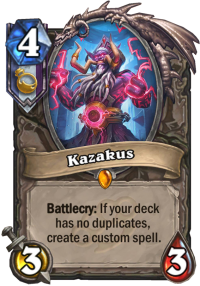
The Kabal are focused on spells and have legendaries that give you a bonus for having no duplicates in your deck. These are Kazakus, Krul the Unshackled, Raza the Chained, and Inkmaster Solia.
In contrast, the Grimy Goons are all about buffing minions in your hand and giving them as much stats as possible. Cards that do this are things like Grimestreet Outfitter and Don Han'Cho.
The last guild, the Jade Lotus, is built off of the idea of Jade Golems. These are minions that slowly build up in power. The first golem you summon is a 1/1, the next is a 2/2, then a 3/3, 4/4, and so-on. Examples of cards that create Jade Golems are Jade Blossom, Jade Lightning, Jade Swarmer, and the tri-class legendary Aya Blackpaw.
The guilds gave the game a new identity, but Mean Streets was most well known for bringing about Pirate Warrior. The hyper-aggro deck dominated the meta for quite a long time, and still holds its own as one of the most popular decks in the game.
Two nerfs came a few months after the set. Small-Time Buccaneer has one health and Spirit Claws costs two instead of one.
If You Left Before Journey to Un’Goro
After Mean Streets came Journey to Un’Goro. This set was especially important to the game because it signaled the second year of Standard, moving from the Year of the Kraken to the Year of the Mammoth. With this release, Blackrock Mountain, The Grand Tournament, and The League of Explorers were moved to Wild.
During this time, Blizzard also announced the “Hall of Fame” set, where they moved some powerful Classic and Basic cards from Standard to Wild. These cards were Ragnaros the Firelord, Sylvanas Windrunner, Azure Drake, Power Overwhelming, Ice Lance, and Conceal. Reward cards were also put into the hall, meaning Old Murk-Eye, Elite Tauren Chieftain, Captain's Parrot, and Gelbin Mekkatorque were moved as well. More cards will likely be added to this set during future rotations.
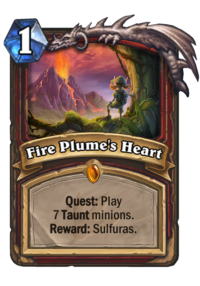
In addition to the Hall of Fame, Journey to Un’goro was a diverse set that introduced a lot of new mechanics to Hearthstone. The biggest one is Quests. Quests are legendary spells that cost one mana and always start in your opening hand (but can be mulliganed away). The way Quests work is, when played, they sit atop your hero and stay there until they are completed. There is one per class and they all have different requirements that, if met, give you a massive reward.
For example, Awaken the Makers gives you Amara, Warden of Hope if you play enough deathrattle, while if you play seven taunt minions with Fire Plume's Heart, you get Sulfuras. Most of the quests have not been strong enough to see play yet, with only The Caverns Below (which was nerfed) and Fire Plume's Heart seeing serious play.
The other two unique attributes that came with Journey to Un’Goro were the Adapt mechanic and the idea of Elementals.
Elementals are a new minion type. Many older cards (such as Unbound Elemental, Baron Geddon and Ragnaros, Lightlord) became elementals with the set. The way the tribe works is that if you have played an elemental the previous turn, you get a strong battlecry. Examples of this are Tol'vir Stoneshaper and Blazecaller. Shaman is the main elemental class, but Priest and Mage have them as well.
The final big change that came with Un’Goro was the adapt mechanic. This is an ability that, when triggered, lets you choose a bonus for your minion. There are ten adapt options in all, and you get to discover one from three random options. You can either give your minion taunt, poisonous, divine shield, windfury, +1/+1, deathrattle: summon two 1/1 plants, +3 health, +3 attack, stealth, or “cannot be targeted by spells or hero powers.” Examples of this mechanic are Crackling Razormaw, Ravasaur Runt, and Volcanosaur.
This set also altered the typical legendary format. Each class got two legendaries; a quest as well as a normal class minion. There were only five neutral legendaries.
Late into the expansion, we’ve seen the first nerf of Year of the Mammoth – The Caverns Below‘s requirement got upped from 4 minions to 5 minions. To put it into some context – Quest Rogue was a pretty popular ladder deck, which had very polarized win rate. On the one hand, it generally lost to any kinds of Aggro decks, but on the other, it was punishing any slow deck, with some of them being nearly auto-win matchups. It wasn’t that problematic on the ladder (more annoying if anything), but it was completely dominating the tournament meta, with nearly every single player bringing it into their line-ups. Because of the slower meta and the ban system, it didn’t look like Quest Rogue would disappear from every tournament any time soon, so Blizzard decided to push the button and nerf it. This change alone turned a quite dominant meta deck into an off-meta, fun list to play around with on the lower end of the ladder. It is not the last time we’ve heard about Quest Rogue, as some players tried to revive it in the next expansions, but it never became a meta deck again (so far).
If You Left Before Knights of the Frozen Throne
Knights of the Frozen Throne was the second expansion of Year of the Mammoth (2017). Without any kind of rotation, it seemed that the expansion would have a lower impact on the meta, but it wasn’t exactly true.
For the first time, a new type of cards was introduced – Hero Cards. It was a way to tell the story of the expansion – of our favorite heroes looking for more power and turning into Death Knights. Instead of introducing a completely new class, which would be problematic, Hero Cards were released. They’re Legendaries which replace your Hero on play. They come with powerful Battlecries, 5 Armor gain and upgraded Hero Powers. Their effects and mana cost vary heavily, but each one of them can be game-changing in the right deck.
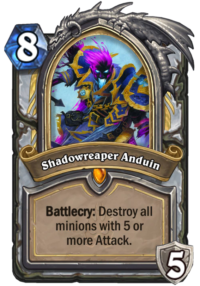
For example, Shadowreaper Anduin spawned a whole new archetype based around its combo with Raza the Chained (which used to make the Hero Power free) – you got 2 more damage after playing any card, meaning that you could often shoot your Hero Power multiple times per turn and perform powerful combos. Bloodreaver Gul'dan is another staple Death Knight – because of its power to revive multiple Demons, it became a mainstay in multiple Warlock decks. The ability to deal 3 damage and heal for the same amount with the Hero Power is also very useful in a class known to sacrifice lots of health.
While not a completely new mechanic, Knights of the Frozen Throne has finally named “damage dealt also heals your hero” effect that was already present on cards such as Mistress of Pain or Wickerflame Burnbristle and introduced multiple new cards (e.g. Chillblade Champion, Obsidian Statue), as well as spells (Spirit Lash) and weapons (Uther of the Ebon Blade‘s weapon) with the same effect. Some of you might remember how the mechanic used to work with cards that turn healing into damage, such as Auchenai Soulpriest. While having it on the board, the effect would loop itself and kill owner of those cards. This interaction was changed, and now it no longer loops – it just deals the damage once and stops there.
A new, deck-oriented mechanic native to Knights of the Frozen Throne was “if your deck contains no card that costs X”. It was introduced through Blood Council, three Legendary princes – Prince Keleseth, Prince Taldaram and Prince Valanar. The initial reception was very negative – most of the reviewers and even casual players didn’t think that the effects would be good enough to justify not playing any cards besides Prince in the respective mana slot. However, it’s not the first time that players turned out to be wrong.
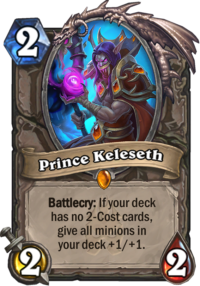
Keleseth was a staple card in many Aggro/Tempo-oriented decks. Some of them (like Zoo Warlock or Tempo Rogue) didn’t have enough strong 2-drops anyway, and hitting Keleseth on Turn 2 was often game-winning. Taldaram sees play in Cube Warlock, as the deck doesn’t really have too many 3 mana cards it would want to run anyway, and copying one of the powerful Deathrattles it runs is a great upside. Valanar has seen some play in Miracle Rogue, but as of now, it remains the least played out of the three princes. Time will tell whether those cards will see more play in the upcoming Year of the Raven.
Other mechanics Knights of the Frozen Throne put more focus on were Deathrattle and Freeze. As much as Deathrattle isn’t anything special, seeing a lot of Freeze cards is more uncommon. Both Mage and Shaman got more ways to Freeze and Freeze synergies, although they weren’t particularly successful.
Knights of the Frozen Throne is the first expansion, which came with free, PvE content. Before, we had either an expansion (only card packs) or adventure (only PvE fights with bosses) – this time we got both. During the adventure part, we would take on the Icecrown Citadel bosses, with The Lich King as our final fight. Beating the Prologue gives players a random Death Knight card (a free Legendary), while beating every other wing awards a single card pack. On top of that, after beating The Lich King with all 9 classes (each fight was different), players are rewarded with Young Arthas Paladin skin.
Early Knights of the Frozen Throne Meta was completely dominated by the Druid class. Not only was it in a good spot back in Un’Goro, but the expansion introduced multiple, powerful tools that made it into an unquestionable Tier 1 class (Spreading Plague, Ultimate Infestation). At one point, about 40% of the ladder were Druids. This lead to a balance patch 5 weeks into the expansion. Surprisingly, besides the Druid nerfs, Blizzard has decided to hit some of the staple, Basic and Classic cards. Here’s a full list of changes:
- Innervate gives 1 mana (down from 2).
- Fiery War Axe costs 3 mana (up from 2).
- Hex costs 4 mana (up from 3).
- Murloc Warleader no longer gives +2/+1 to ALL Murlocs. Instead, it only gives +2 Attack to YOUR Murlocs (doesn’t affect the opponent’s side).
- Spreading Plague costs 6 mana (up from 5).
Those changes lead to a drastic change in the meta. Druid was still strong, but not as dominating as it was before. Fiery War Axe change nearly completely killed Warrior, especially Pirate Warrior, which really relied on the early game weapons. Warleader nerf didn’t really impact Murloc Paladin’s performance that much, but it did impact the deck’s popularity – most people disenchanted Warleaders and no longer played Murlocs. As for the post-nerf meta, it was mostly dominated by the Highlander Priest (Raza the Chained + Shadowreaper Anduin combo discussed above) and tempo-heavy decks with Prince Keleseth.
If You Left Before Kobolds & Catacombs
On December 6th, the final expansion of Year of the Mammoth was released – it was called Kobolds & Catacombs. The expansion’s theme was based on the old-school tabletop RPGs, as well as dungeon crawl games. At this time, it’s the latest expansion, but we’ve got a new one coming out in about a month.
Even before the expansion started, every player got a free copy of Marin the Fox to celebrate the upcoming expansion.
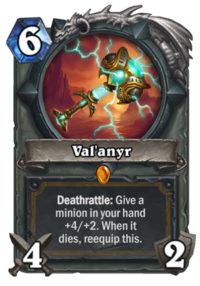
Kobolds & Catacombs was the first expansion ever introducing Legendary weapons. For the first time, every single class had access to their own weapon. However, it’s not like Mage or Priest would start swinging a sword at the opponents – weapons from the classes that normally didn’t have access to one came with low (or zero) attack and powerful effect instead. Each of the weapons is unique and very synergistic with the class they belong to. And so, for example, Warlock can summon Demons from the hand (Skull of the Man'ari), Paladin can buff minions in the hand infinitely (Val'anyr), while Druid can gain 10 mana (Twig of the World Tree. Unlike Hero cards from Knights of the Frozen Throne, weapons didn’t turn out to be as powerful. Since they had more clear counters and downsides, only a few of them ended up seeing common play. However, given that they will still be in Standard for another year, it is very probable that even the less popular ones (such as Woecleaver or Dragon Soul) will be seen more often. Every player has got a free, random Legendary weapon just for logging into the game after the launch.
On top of the Legendary weapons, Kobolds & Catacombs expansion has introduced a new keyword – Recruit. The effect is very similar to what we’ve already seen with Y'Shaarj, Rage Unbound (although the card didn’t get its text changed to Recruit). Recruiting a card means pulling a minion from your deck straight into the battlefield, thus ignoring any Battlecries (positive or negative). We’ve seen Recruit cards in many different flavors – simple Recruit cards (Gather Your Party), cards recruiting minions with a certain mana cost (Call to Arms) or even a certain tribe (Possessed Lackey).
Another mechanic unique to Kobolds & Catacombs were Spellstones – each class got one of them. Spellstones are like mini-quests that activate when the card is in your hand. After you meet a certain condition, the card gets upgraded into a more powerful version. Then after doing it again, it gets upgraded a second time. Generally, the first version is weak for a card of its mana cost, the second version is good (above average card that you would definitely want to put into your deck), while the third version is incredibly powerful, a card with its strength way above the mana cost of the Spellstone. And so, for example, Lesser Amethyst Spellstone starts as a 4 mana spell that deals 3 damage to a minion (with Lifesteal, which means that it heals for as much as it deals damage). After taking damage from your own card (e.g. Kobold Librarian or Hellfire) it gets upgraded to deal 5 damage, and finally, after taking damage again, it deals 7 damage. The final version is incredibly powerful, as dealing 7 damage and healing for the same amount for just 4 mana is insane, especially in the Warlock class.
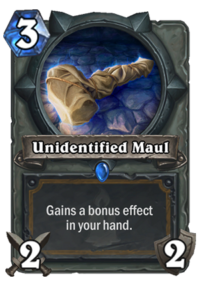
The last new mechanic from Kobolds & Catacombs are unidentified items. We’ve got three of them (Unidentified Elixir, Unidentified Maul and Unidentified Shield), but their basic premise is pretty much the same. When the card is in your deck, it’s unidentified – so there is no way to tell what effect it will have. Only when you draw it, it randomly picks one of the four possible effects. For example, the Paladin’s weapon can pick between giving all your minions +1 Attack, Taunt, Divine Shield or summoning two 1/1 Silver Hand Recruits. Each one of those effects (maybe besides Taunt) would be very powerful if it came on a 3 mana weapon, but since you can’t control which one you’re getting, the card’s value goes down by a bit.
Kobolds & Catacombs introduced some very popular PvE content. Unlike Knights of the Frozen Throne, which simply added some boss fights, this time a whole new game mode was added – Dungeon Run. It’s PvE content, where you fight against eight (from the pool of over 40) random bosses. Progressing gets harder after every boss, and the final fight is always against one of the five most difficult encounters. At the same time, you also get stronger, because you get extra health, pick more cards and even gain powerful artifacts, which make boss fights more fair (e.g. you can start with an extra mana crystal, your Deathrattles might trigger twice, or you might even get an extra turn). A series of Quests, rewarding 3 card packs in total, were tied to your first Dungeon Runs.
Just like the last few expansions, Kobolds & Catacombs also had its own nerf patch. Pre-nerf meta was absolutely dominated by a single card – Corridor Creeper. Another sleeper card, which players didn’t rate too highly. As it turned out, it was very easy to get it down to 0 mana (or at least 2-3 mana) in a meta full of decks that flood the board. And dropping a cheap or free 5/5 minion was such a big tempo swing that the opponent often had no way of coming back, other than dropping their own Creeper. And so, at its peak, the card was present in about 50% of the decks on the ladder. Only Control & Combo decks didn’t want to run it. The balance patch came a bit later than in Knights of the Frozen Throne, 2 months into the expansion, but it contained four changes that changed the meta heavily.
- Corridor Creeper now has 2 Attack (down from 5).
- Bonemare now costs 8 mana (up from 7).
- Raza the Chained now turns the cost of Hero Power to 1 mana (up from 0).
- Patches the Pirate no longer has Charge.
If You Left Before The Witchwood
Released on April 12th, 2018, The Witchwood is the first expansion of Year of the Raven (2018), which means that every expansion from Year of the Mammoth (2016) has rotated out of Standard. On top of that, three cards have rotated into Hall of Fame: Ice Block, Coldlight Oracle and Molten Giant. It’s also the first time ever they’ve decided to revert a nerf – Molten Giant got changed back to 20 mana at the same time it rotates out.
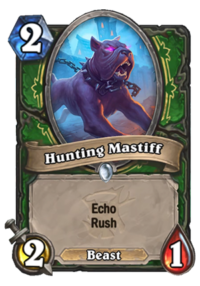
Witchwood has introduced two new mechanics – Echo and Rush. Cards with Echo can be replayed any number of times during a single turn. If you have a 2 mana Echo card (e.g. Hunting Mastiff) and 8 mana, you can play the card up to 4 times. Rush mechanic is similar to Charge, with a single exception – a minion with Rush can’t attack the opponent on the turn its played, they can only attack minions. Rush minions are very useful for board control, but they can’t be a part of OTK combos like a lot of the problematic Charge cards were in the past. Rush is a recurring mechanic, which has been featured in every expansion since its introduction. On the other hand, Echo was so far limited to The Witchwood – no new Echo cards were printed yet.
While the expansion hasn’t introduced any new types of cards, the main theme (which turned out to be unexpectedly successful) were Even and Odd decks, a new deck building restriction akin to Reno Jackson or Princes from Knights of the Frozen Throne.
Baku the Mooneater is Odd decks activator. When you put it into your deck and don’t play any even-costed cards, your Hero Power is upgraded at the start of the game (those are the same upgrades as from the Justicar Trueheart‘s Battlecry). The most successful Odd decks have been Odd Paladin (Summoning 2x Silver Hand Recruit), Odd Rogue (Equipping a 2/2 weapon) and Odd Warrior (Gaining 4 Armor).
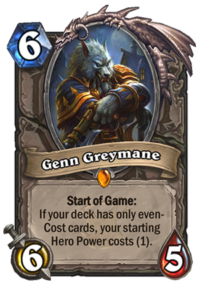
Genn Greymane is Even decks activator. When you put it into your deck and don’t play any odd-costed cards, your Hero Power costs 1 for the entire match. The most successful Even decks have been Even Warlock, Even Paladin and Even Shaman. As you can see, Genn works best with the Hero Powers that actually do something on Turn 1.
The Witchwood’s Single Player content is Monster Hunt, which is kind of an upgraded version of Kobolds & Catacombs’ Dungeon Run. You play as one of the four custom Heroes, with lots of new cards and abilities, and fight your way through the haunted forest. In order to win, you need to beat 8 bosses. Every encounter, you will get to add cards to your deck (you pick one of the three pools of cards), and every second encounter you can add an extra powerful passive or card that will boost your deck’s power significantly.
On May 22, 2018, a balance patch was released, which nerfed 6 cards. It was the first patch that actively balanced the Wild format too. Here are all of the card changes:
- Call to Arms – Now costs 5 mana, up from 4.
- Possessed Lackey – Now costs 6 mana, up from 5.
- Spiteful Summoner – Now costs 7 mana, up from 6.
- Naga Sea Witch (Wild) – Now costs 8 mana, up from 5.
- The Caverns Below – Ongoing buff provided by the Quest’s reward (Crystal Core) has been changed from 5/5 to 4/4.
- Dark Pact – Now restores 4 health, down from 8.
If You Left Before Boomsday Project
Boomsday Project was released on August 7th, 2018, as the second expansion of the Year of the Raven. Boomsday Project’s theme was Dr. Boom‘s lab in Netherstorm, with crazy scientific (or sometimes less scientific) experiments that are happening there.
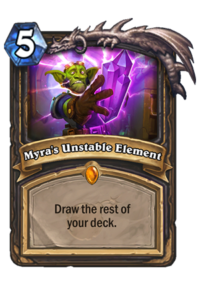
Each class has got two Legendaries. The first one was a scientist working in Dr. Boom’s Lab (and of course Dr. Boom, Mad Genius himself, which was featured as the Warrior’s Hero card), while the second one is one of its experiments. While not exactly a new type of cards, Boomsday Project is the first expansion in which we’ve got to play around with Legendary Spells. They are cards with often very powerful and crazy effects, but limited by the fact that they’re Legendary (so you can only put one of them per deck). Some of the more successful ones include Myra's Unstable Element, The Soularium and Zerek's Cloning Gallery.
Boomsday Project was the first expansion since Goblins vs Gnomes to have Mechs as the main tribe. On top of adding a lot of Mech cards, we’ve also got a new, Mech-centered keyword – Magnetic. A card with Magnetic can be played on its own, or attached to any other Mech that’s already on the board in a form of a buff. If you magnetized a card into another card, it took all of its stats as well as effects. While the full Mech decks didn’t really take off, some of the Mech cards became a mainstay in the meta. For example, the new Neutral Legendary – Zilliax – is one of the most popular cards from the entire expansion.
On top of the Legendary spells and Mechs, we’ve got some Project cards and Omega cards. Project cards were regular class spells with mirrored effects – they were very powerful for their mana cost, but they gave the same effect to your opponent. The idea behind them was to run them in a deck that can take a better advantage of this effect than the average opponent. The Project cards we’ve got were Biology Project, Research Project, Demonic Project and Weapons Project. Out of them all, only Warlock’s and Druid’s Projects have seen some more play.
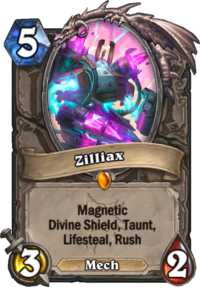
As for the Omega cards, players didn’t have very high hopes for the mechanic and they were right. Out of five Omega cards – Omega Defender, Omega Agent, Omega Medic, Omega Mind and Omega Assembly, only the last one has seen quite a lot of competitive play.
Boomsday Project’s PvE content is Puzzle Lab, which is completely different than everything we’ve seen before. We have four different labs – Lethal, Survival, Board Clear and Mirror. Each of them features a long series of puzzles. In the Lethal Lab, you’re obviously looking for a way to kill your opponent. In Survival Lab, you need to find a way to heal yourself up to full. In the Board Clear Lab, you need to clear an entire board, including your own minions. And in Mirror Lab, you need to manipulate the board in a way that both sides will look exactly the same (same minions, same amount of attack / health etc.). There are over 120 different puzzles in total, and while the first ones are very easy, lots of the final ones were challenging even to the best Hearthstone players!
Boomsday Project also had a balance patch, which happened on October 18th, 2018. Three cards in total got changed:
- Mana Wyrm – Now costs 2 mana, up from 1.
- Giggling Inventor – Now costs 7 mana, up from 5.
- Aviana (Wild) – Now costs 10 mana, up from 9.
If You Left Before Rastakhan’s Rumble
Rastakhan’s Rumble is the final expansion of Year of the Raven, which is about to be released on December 4th, 2018. To learn more about the expansion, you can visit our Rastakhan’s Rumble Information Guide. We’ll update this article with information about Rastakhan’s Rumble after it launches!










Thanks so much, Meg!
Should you mention how they changed the ranked format?
Lil correction: Before, Murloc Warleader was +2/+1 to all murlocs on board. Now is +2/+0 AND for YOUR murlocs only.
You’re right, I completely forgot about it, fixing it now!
You need to update the part about the old gods play. Currently yshaarg gets the most play followed by nzoth. Also in the beginning when talking about nerfed cards you said none get real play, well knife juggler does in aggro paladin decks especially dude decks.
Sorry! I’ve mostly focused on adding the last few sets, and didn’t fix all of the outdated information. Should be good now, thanks 🙂
Actually, N’Zoth is enjoying the most play right now. According to HSReplay, 13.9% of decks run N’Ztoh while only 5.2% run Y’Shaarj. For completeness, Yogg-Saron is played in 0.9% of decks and C’Thun in only 0.7% of decks.
Overall a nice job — you should consider adding Mage to your analysis of the meta; burn mage is still very popular.
I thought you get the free random DK heroecard after completing the prologue not after beating the Lichking.
you get the free DK after the first mission. You cant per say “defeat” the linch king but after finishing it you do receive a random DK card
If I have opened certain packs before the patch, does the 10 reset then? Or is it only with brand new players that have not bought packs?
It’s like you said, for new players only. If you however have not opened any packs from an expansion (like TGT was new for me) you may then take advantage of this patch still. Same goes for new, upcoming expansions. Like frozen throne
Are the pack changes into effect now with the patch? or when the expansion is released?
Pack changes went live last week sometime. Was a server side change, no need to update the client, just bust open the packs.